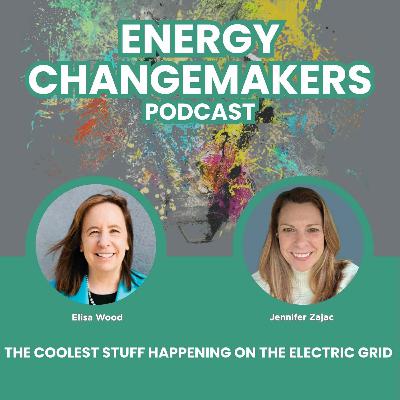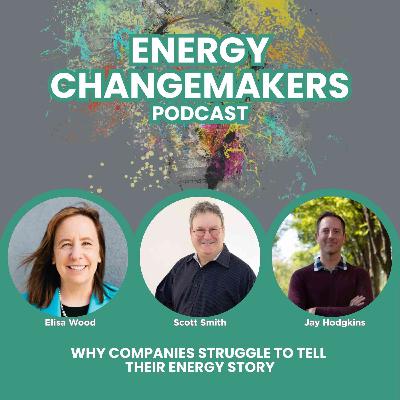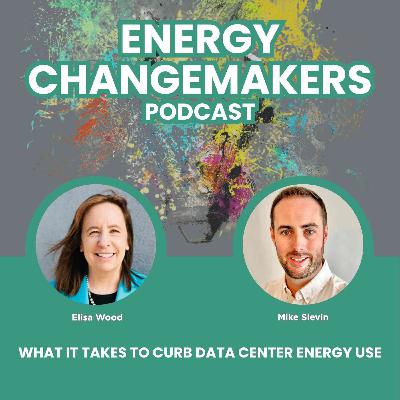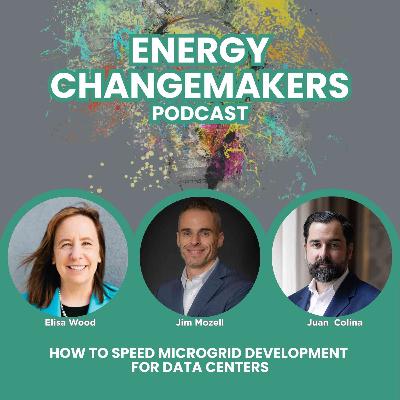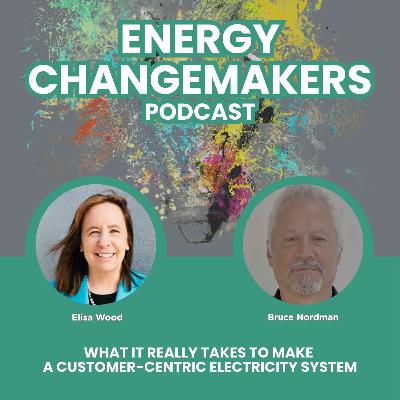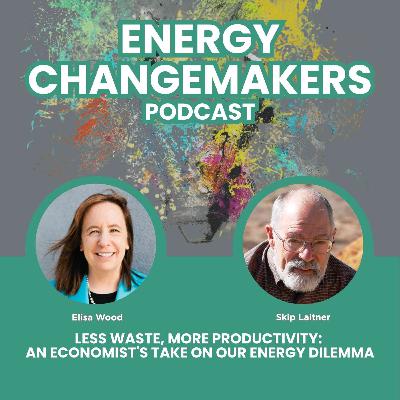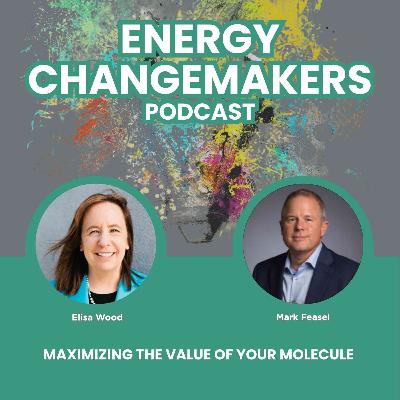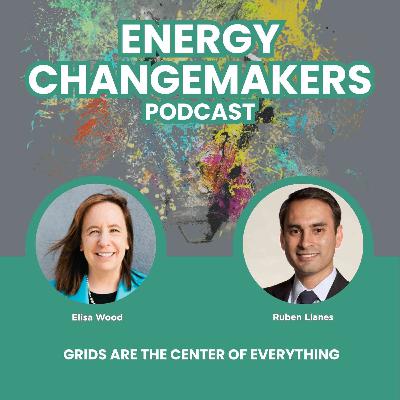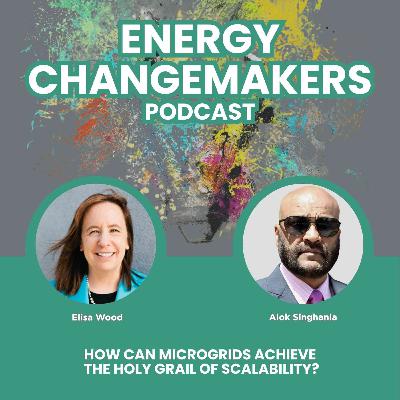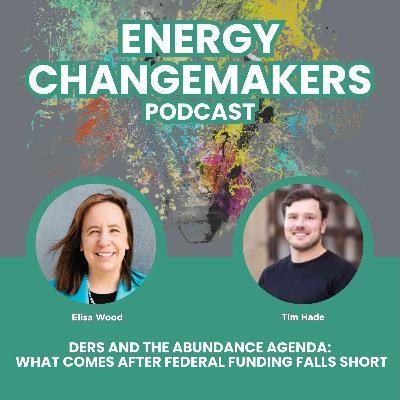Discover Energy Changemakers Podcast
Energy Changemakers Podcast

Energy Changemakers Podcast
Author: Energy Changemakers
Subscribed: 5Played: 100Subscribe
Share
© Energy Changemakers
Description
As the energy grid faces unprecedented changes, local energy solutions are increasingly needed. Hosted by Elisa Wood, an experienced energy journalist, The Energy Changemakers Podcast brings you into the heart of these transformations. Each episode features in-depth discussions with industry leaders pioneering the move toward a decentralized grid. From technological innovations to policy changes — discover actionable insights to help your company leverage emerging opportunities. Join us at The Energy Changemakers Podcast and be part of the conversation that shapes our energy future.
33 Episodes
Reverse
In this special crossover episode, Energy Changemakers host Elisa Wood joins Jennifer Zajac on Clean Energy Shorts to talk about the most exciting innovations reshaping the electric grid. From mega-microgrids to driveway solar, Elisa reveals what’s really happening behind the headlines—and why the clean-energy story is about more than politics.They unpack the myths driving public perception, explore new business models making microgrids affordable, and discuss why flexibility—not nuclear—defines the future of energy. The conversation also highlights inspiring examples of resilience, from Ukraine’s grid recovery efforts to local U.S. communities taking ownership of energy.This is an optimistic, insight-packed conversation that celebrates innovation, collaboration, and a more distributed, consumer-controlled grid.Episode BreakdownIntroductionElisa introduces the crossover episode and sets the stage for her discussion with Clean Energy Shorts host, Jennifer Zajac.Misconceptions About Clean EnergyWhy the public conversation about energy often misses the real story—and what’s actually driving today’s grid transformation.Politics and PowerElisa and Jennifer discuss the political polarization around renewables and why the market ultimately dictates the future of energy.The Coolest Innovations on the GridFrom Eaton and Siemens’ large-scale modular microgrids to a family-run company developing driveway solar, Elisa shares her favorite new technologies.The Rise of the MicrogridHow Hurricane Sandy, resilience needs, and entrepreneurial innovation made “microgrid” a household word—and how businesses are adopting them faster than ever.Making Microgrids AffordableThe evolution of business models—like “microgrid as a service”—that make distributed energy accessible to communities and companies alike.Supply Chain RealitiesElisa explains how microgrids are sidestepping the bottlenecks that plague large power plants and the transmission grid.Investment TrendsWhy investors remain confident in microgrids and solar despite shifting tax policies and tariffs.Why Nuclear Won’t Lead the FutureA candid discussion on small modular reactors (SMRs) and why nuclear energy doesn’t fit a software-driven, flexible grid.Data Centers’ Growing PainsInside the data-center boom: power shortages, desperate solutions, and NIMBY resistance from communities nationwide.Lessons from UkraineWhat the ongoing war teaches about grid vulnerability, cascading failures, and the need for distributed, resilient systems.Footprint Project & Disaster RecoveryProfiles of organizations deploying mobile solar microgrids to restore power after disasters—and what utilities can learn from them.The Next Energy Frontier: Local ControlElisa shares her excitement for community-owned solar and microgrids, and how local energy control can lower costs and increase reliability.Real Stories of Community SolarWhy even the most innovative models sometimes require old-school door-knocking to make community energy projects work.Wrapping Up: Hope for the FutureElisa reflects on her new venture, Energy Changemakers, and the inspiring innovations shaping a decentralized, equitable energy landscape. Relevant LinksEnergy Changemakers: https://energychangemakers.comClean Energy Shorts Podcast: (Search wherever you get your podcasts)Footprint Project: https://www.footprintproject.orgMicrogrid Knowledge: https://microgridknowledge.com
Why do many energy companies struggle to connect with stakeholders despite strong technical credentials? Why is it so hard for them to tell their story, and what could make it easier?Elisa Wood brings together two communications experts who have helped a range of organizations find their stories: energy writer-editor Jay Hodgkins and podcast strategist Scott Smith. Why stories are remembered and spec sheets are notHow to frame renewables amid misinformation and political headwindsWhen to avoid acronyms and insider termsWays to adapt your message across formats like podcasts, blogs, and webinarsThe simple, human description of “spinning reserves” and why it mattersThree quick rules any subject matter expert can use to communicate betterHow consistent narratives build credibility through government policy cycles Why imperfection reads as human, especially in an AI-polished world.Listeners come away with concise rules for subject matter experts, guidance on differentiation in crowded B2B markets, and examples of translating technical precision into benefits that matter to customers, regulators, and community leaders. The throughline is simple communication that is truthful, human and focused on outcomes.“People do not remember facts. They remember stories.”“Fight fire with water. Lead with facts and aim them at the people who can act.”“Your customer is the hero. You are the guide.”“Acronyms are the enemy of attention.”“There is always a way to tell the same truth in a way that fits the moment.”“Keep it short. Your audience does not care as much as you do.”“Pick the channel after you define the message.”“Imperfections read as human. That is an advantage now.”“If we add renewables without stability tools, the grid can wobble. Batteries fix the wobble.”“Differentiate by benefit, not by feature.”Elisa WoodJournalist and host of Energy Changemakers. She covers distributed energy, microgrids, and the decentralized grid and leads Energy Changemakers Content Services.Jay HodgkinsFreelance energy writer and editor who helps companies translate complex energy topics into messages that customers and regulators understand. Jay and Elisa are long-time collaborators, previously at Real Energy Writers and now at Energy Changemakers.Scott SmithPresident and Chief Podcasting Officer at Penbury Consulting. Formerly with Gartner, where he led podcasts and moderated prospect-facing webinars. Specializes in spoken-word strategy and helping experts tell memorable stories.What You’ll LearnNotable QuotesWho’s On The Mic
Are data center forecasts overblown? Will energy efficiency trim megawatts and even gigawatts off predictions? And if so, what must data centers do to significantly curb their energy use? In this episode, host Elisa Wood talks with Mike Slevin of Fluke about what it really takes to make data centers more efficient. They discuss how small, everyday improvements in equipment performance add up to big savings, the growing role of solar and microgrids, and how the shift to DC power could change the game for the industry.Why “micro gains” in maintenance can lead to major energy savingsThe difference between short-term fixes and long-term technology shiftsHow solar, microgrids, and DC systems are reshaping power strategiesRegional differences in sustainability and innovationWhat grid operators can do right now to prepare for rising data center demandMike Slevin is a Business Unit Manager at Fluke, a company known worldwide for its electronic test and measurement tools. Mike works with data centers and industrial clients to improve energy efficiency, safety, and reliability through better monitoring and maintenance practices.Fluke CorporationEnergyChangemakers.comCall to ActionIf you found this episode helpful, follow The Energy Changemakers Podcast and leave a review. Join the conversation about grid edge innovation at EnergyChangemakers.com.Key TopicsGuest BioResources
Utility monopolies were meant to keep the lights on, but have they also opened the door to corruption that slows energy innovation?Elisa talks with Dick Munson, veteran clean-energy advocate and author of Power Corrupts, about the scandals that rocked utilities like Commonwealth Edison and FirstEnergy, why the century-old monopoly structure invites abuse, and how bribery and dark money can stall the transition to cleaner, distributed power.How billion-dollar bailouts in Illinois and Ohio exposed deep utility corruptionWhy state-sanctioned monopolies create perverse incentives and resist prosumer techPractical reforms—from transparency to shareholder-funded lobbying—that could break the cycleWhy “clean government” is essential for a clean-energy futureDick Munson’s book: Power CorruptsMore on Elisa Wood and Energy Changemakers: energychangemakers.comFollow Elisa on LinkedIn: Elisa WoodRelated reading: Citizens United decision overview | Environmental Defense FundListen & Subscribe: Apple Podcasts | Spotify | Google Podcasts | Your favorite podcast app
Two energy giants come together with a new strategyThe global data center boom is colliding head-on with one of the most pressing bottlenecks in the energy sector: access to reliable, timely power. In this episode, host Elisa Wood sits down with Jim Mozell, senior director of strategic partnerships at Siemens Energy, and Juan Colina, data center and IT segment leader at Eaton, to discuss how together they are trying to overcome interconnection delays and provide “speed to power” for microgrids.While many data center developers scramble for quick fixes—from reviving retired plants to chasing speculative nuclear projects—these two energy giants came together to propose a “power to chip” approach. The result, they say, is faster deployment timelines, optimized efficiency, and a more financially sustainable way to meet AI-driven compute demand.This conversation explores:● Why interconnection delays (often 7–9 years) are driving data centers to rethink power strategies● How Siemens and Eaton’s microgrid design enables modular, onsite generation—scalable from 250 MW to a gigawatt● The critical role of redundancy, efficiency, and combined-cycle technology in meeting massive compute demand● How data centers can shift from being heavy consumers to becoming good grid citizens● Global regulatory challenges and opportunities across the U.S. and Europe● Why slowing down the “frenzy buying” of energy deals could save operators money and optimize long-term sustainabilityAbout the GuestsJim MozellSenior Director of Strategic Partnerships, Siemens EnergyJim leads collaborations that address global energy challenges through scalable, efficient technology. At Siemens Energy, he works on integrating advanced power generation systems into industrial applications, including the fast-growing data center sector.Juan ColinaData Center & IT Segment Leader, EatonJuan is responsible for shaping Eaton’s global strategy for powering next-generation data centers. With expertise in modularization, resilience, and electrical distribution, he focuses on helping operators scale sustainably while ensuring reliability from “onsite generation to chip.”The market panic around securing power for data centersWhy Eaton and Siemens chose a modular microgrid approachTechnical components: Siemens’ SGT-800 turbines, batteries, and Eaton’s switchgear/UPS solutionsHow modular scaling helps manage CapEx and growth timelinesThe opportunity cost of waiting for grid connections vs. generating onsiteFinancial viability and efficiency as essential long-term considerationsRegulatory hurdles in Europe and North AmericaFuture vision: campuses and hub-and-spoke models supported by optimized onsite powerRelevant LinksEnergy Changemakers PodcastSiemens EnergyEaton Data Centers📩 Have questions or insights? Email Elisa at ElisaWood@energychangemakers.com to keep the conversation going.Call to ActionKey Topics CoveredIf you’re interested in how local energy innovations are reshaping the grid—and the future of data centers—subscribe to Energy Changemakers wherever you listen to podcasts. Leave us a review to help others discover the show, and join our newsletter community at energychangemakers.com to stay ahead of the curve.
Guest: Bruce Nordman, Retired Research Scientist, Lawrence Berkeley National LaboratoryAfter nearly 40 years at Lawrence Berkeley National Laboratory, Bruce Nordman has stepped into retirement — leaving with some big ideas about the future of our electricity system. In this episode, host Elisa Wood speaks with Bruce about the insights he’s gathered over his career and why he believes the grid has strayed from its original purpose: serving customers.Bruce argues that today’s electricity system is structured around the needs of the grid, rather than those of the consumer. He makes the case for a reimagined model—one where electricity behaves more like the internet: plug-and-play, universal, and simple for the end user. From networking electricity inside buildings to creating globally harmonized standards, Bruce shares a vision for how to make energy systems both more efficient and more customer-friendly.This conversation covers:Bruce’s pioneering work on the energy use of electronics and IT networks at LBNLHow a “lightbulb moment” in 2010 changed the trajectory of his careerWhy electricity should be networked like the internet—universal, seamless, and behind-the-scenesThe hidden complexity of today’s demand response and why it burdens customers unnecessarilyWhy virtual power plants miscast customers as power plants rather than treating them as customersThe three essential ingredients for a truly customer-centric electricity system:Dynamic pricingCommunications infrastructureAutomation at the device levelLessons from Scandinavia, California, and Australia—and why no place has yet put all the pieces togetherWhat global harmonization would mean for future innovation and affordabilityBruce also shares his optimism about what lies ahead and why he believes the greatest barrier isn’t technology—it’s changing the way we think about the grid.Bruce Nordman recently retired after nearly four decades as a research scientist at Lawrence Berkeley National Laboratory. His work has focused on energy efficiency in electronics and IT networks, the intersection of digital technology with electricity use, and advancing standards to support smarter, more sustainable systems. His innovative thinking has shaped policy, regulation, and the way we view the customer’s role in the grid. Today, Bruce continues to consult and advocate for globally harmonized, customer-centered approaches to the electricity sector.Learn more about Bruce Nordman on LinkedIn or at brucenordman.com Join the Energy Changemakers community: energychangemakers.comFollow host Elisa Wood on LinkedInIf you enjoyed this conversation, don’t forget to subscribe to the Energy Changemakers Podcast on your favorite platform and leave us a review. Want to shape the dialogue on the decentralized grid? Sign up for our newsletter at energychangemakers.com.Together, we can build a grid that’s local, equitable, and clean.About the GuestResources & LinksCall to Action
In this episode of Energy Changemakers, host Elisa Wood sits down with renowned energy economist Skip Laitner to explore the surprising ways our “stuff” — from food waste to excess parking lots — is shaping our energy use, economy, and environment. Drawing from his decades of work at the EPA, ACEEE, and beyond, Skip reframes the energy conversation from simply producing more to using resources more productively.Using vivid, household-level examples, Skip reveals how the sheer mass of human-made materials now likely outweighs all living biomass on Earth — and why that matters for energy demand. He discusses:How household habits, from car ownership to shoe purchases, add hidden costs to our energy systemThe difference between energy efficiency and energy productivity — and why the latter could cut total energy use in halfThe role of distributed energy systems in making people more aware of their consumption and wasteHow smarter policies and greater investment could boost economic resilience while reducing environmental pressuresWhy repurposing and reuse — not “degrowth” — are key to a healthier economy and planetFrom the economics of waste to the scaling lessons we can learn from biology, Skip offers a big-picture view that connects our personal consumption patterns to global policy choices. If you care about making the grid cleaner, more local, and more equitable, this conversation will leave you thinking differently about where real change begins.🔗 Download Skip’s paper Living More by Waste Than Ingenuity https://www.researchgate.net/publication/330383360_Let's_Talk_Trash_Do_We_Live_More_by_Waste_than_IngenuityConnect + ResourcesLearn more about the Energy Changemakers community: energychangemakers.comFollow host Elisa Wood on LinkedIn
As rising sea levels, floods, and wildfires continue to impact large swaths of the U.S., many people will be displaced from the coasts to the middle states. Hillary Brown, former director of the Urban Sustainability Program at City College of New York, sees this as an opportunity for faltering, inland communities to capture new economic opportunities — if they prepare for population growth now. Cultivating clean distributed energy resources is a key step.In this episode, Hillary dives into the policy frameworks, energy planning, community-led models, and financial opportunities that can help small towns thrive while providing a lifeline for those displaced by climate change.What You’ll Learn in This Episode:What climate migration looks like in the U.S.—and why it’s already underwayWhy many people are still moving to climate-vulnerable areas like Florida and the SouthwestHow small towns can prepare to welcome newcomers and strengthen their local economiesThe role of distributed energy systems—solar, wind, microgrids, and storage—in climate-ready planningReal-world examples of small towns transforming through grassroots efforts, tax incentives, and energy innovationHow philanthropic investment and private sector engagement can support local resilienceThe importance of Main Street revitalization in creating economically viable, socially connected communitiesAbout the Guest:Hillary Brown is a leading voice in urban sustainability and infrastructure planning. She served as director of the Urban Sustainability Program at City College of New York and is the author of several books on next-generation infrastructure. Her most recent book, Revitalize Resettle: How Main Street USA Can Offer New Beginnings for America’s Climate Displaced, offers a practical, visionary blueprint for how small towns can prepare for climate migration and create stronger, more resilient communities in the process.Resources and Links:Revitalize Resettle: How Main Street USA Can Offer New Beginnings for America’s Climate Displaced — available via Amazon, Barnes & Noble, and other major booksellersMaking Rural America into a Climate Migration Mecca with the Help of Distributed Energy, Energy Changemakers, 8/8/2024Explore more conversations on the decentralized grid at energychangemakers.comSubscribe to the Energy Changemakers newsletter for industry updates and insightsCall to Action:Subscribe, leave a review, and share this episode with colleagues in planning, energy, or local government.
Elisa Wood interviews Mark Feasel — a former leader at Schneider Electric and FuelCell Energy, and now an independent energy consultant — about the growing tension between energy demand and access in the age of AI. As data centers proliferate and energy demand rises, utilities and innovators face a new challenge: Where will the power come from?Mark shares his perspective on how distributed energy resources (DERs), grid constraints, and new power generation models may reshape our energy infrastructure. They discuss the blank-slate reality of many AI-driven projects, the rise of fully onsite generation, regulatory hurdles, and what the future may hold if some of the most powerful companies in the world begin generating their own electricity.What You’ll Learn in This Episode:Why access to grid capacity is becoming the new barrier for data centersHow AI’s energy needs are reshaping assumptions about utility-scale powerThe evolving relationship between DERs and utilities—from competition to collaborationWhy “oceanfront property” is the new metaphor for grid interconnectionThe surprising role coal and methane may play in next-gen energy systemsHow modular, scalable solutions are driving innovation in onsite powerWhat Mark is seeing in the classroom as he teaches the next generation of energy leadersGuest Bio:Mark Feasel, a long-time leader and innovator in the distributed energy space, is the founder and principal of VisRete, a consultancy that services related to energy management, digitalization, microgrids, power grids and distributed generation. He previously served in senior roles at Schneider Electric and FuelCell Energy. Mark also teaches at Northwestern University’s graduate program in Energy and Sustainability, where he mentors the next generation of changemakers. His experience bridges policy, business strategy, and engineering, offering a rare depth of insight into the evolving energy landscape.Energy Changemakers NewsletterSubscribe on Apple PodcastsSubscribe on SpotifyLearn more about Northwestern’s Energy & Sustainability ProgramConnect with Elisa Wood:LinkedIn: Elisa WoodCall to Action:Want to help shape the future of the grid? Join the Energy Changemakers community by subscribing to our newsletter and following us on your favorite podcast platform. Share this episode with someone curious about how AI, regulation, and private capital are influencing the power grid of tomorrow.
What exactly is a “digital grid”—and why is it the cornerstone of our energy future?In this episode, Elisa Wood sits down with Ruben Llanes, CEO of the Digital Grid business at Schneider Electric, to explore the digital transformation of energy infrastructure. With over 15 years at Schneider and a lifetime surrounded by energy systems (his father owned an electrical contracting business), Ruben shares his insider perspective on why grid modernization is the key to managing the explosive growth of data centers, aging infrastructure, and prosumer energy participation.From rethinking load growth and AI-driven energy demands to unveiling Schneider’s One Digital Grid platform, Ruben offers a hopeful but urgent message: the technology exists—but will we move fast enough?Ruben’s journey from Deutsche Bank to leading digital grid innovation at Schneider ElectricWhat a digital grid actually means—and how it changes everything from asset management to customer engagementHow distributed energy, electrification, and AI are reshaping grid demandsWhy aging infrastructure and long interconnection queues are major challengesThe role of grid management software and “non-wire alternatives” in solving energy supply gapsIncentive structures and regulatory shifts needed to accelerate modernizationSchneider’s One Digital Grid platform and how it unifies IT, OT, and third-party applicationsUse cases powered by AI and integrated data ecosystemsA vision of the future: resilient, intelligent, consumer-empowering gridsRuben Llanes is the CEO of Schneider Electric’s Digital Grid business, where he oversees the integration of software, analytics, and system intelligence into the global energy infrastructure. With over 15 years at Schneider Electric—and prior experience at Deutsche Bank—Ruben brings a rare combination of financial expertise, operational leadership, and visionary thinking to the role. He previously led AutoGrid and has deep insight into the technological and regulatory forces shaping the future of energy.Schneider Electric Digital Grid AutoGrid (acquired by Uplight)Esri GIS SolutionsAI Dash – Vegetation ManagementDistributech InternationalIf this conversation sparked new ideas about grid transformation, help keep it going:Subscribe to the Energy Changemakers Podcast
Scaling microgrids has long been a sticking point in the clean energy conversation—custom-built and complex, they’ve traditionally defied mass deployment. But what if microgrids could be treated as products rather than projects?In this episode of the Energy Changemakers Podcast, host Elisa Wood sits down with Alok Singhania, Senior Partner at Gridscape, to explore how standardizing microgrids can reshape the energy landscape. Alok unpacks Gridscape’s innovative approach to making microgrids modular, scalable, and manufacturable, like any other piece of equipment. Together, they examine regulatory roadblocks, federal policy uncertainty, and the educational gaps holding back market adoption.From tribal installations to community colleges, Alok shares real-world examples of Gridscape’s work, outlining a clear path to making microgrids central to a decentralized, resilient, and equitable grid of the future.Why most microgrids are stuck in a “custom project” loopGridscape’s approach to productizing microgrids for scaleHow permitting delays and lack of public understanding slow adoptionWhy a decentralized grid is critical for resilience and cost savingsThe impact of utility policy and the “over-the-fence rule”How community microgrids could become the future of energy infrastructureReal-world examples from fire stations, tribal lands, and college campusesInsights on federal tax incentives, tariffs, and future-proofing the industryAlok Singhania is a senior partner at Gridscape, a microgrid technology and project development company based in the San Francisco Bay Area. With a background in both technology and entrepreneurship, Alok has been instrumental in transforming microgrid systems from custom installations into scalable, modular energy solutions. His work supports communities, critical infrastructure, and institutions in their journey toward energy independence and grid resilience.Gridscape SolutionsU.S. Investment Tax Credit (ITC) overview: energy.govSan Pasqual Band of Mission Indians Microgrid Case StudyShabo College Microgrid ProjectFremont Fire Station CEC Microgrid Project🔗 Website: https://energychangemakers.com/📩 Newsletter: Subscribe for weekly insights on the decentralized grid📣 Spread the word: Rate & review the podcast to help grow the clean energy conversation!The Energy Changemakers Podcast is your source for expert insights into building a decentralized, local, and equitable energy future. Subscribe and join the movement.
In this episode, Elisa Wood sits down with Tim Hade to discuss why now—despite, or perhaps because of—federal policy turbulence, the distributed energy industry is poised for massive transformation. Tim unpacks his move to Santa Barbara (which, by the way, he calls “home to the worst grid in the continental U.S.”) and how that community could become a national model for DER-powered resilience.They explore why community organizing is becoming just as crucial as engineering, how local governments are key players in energy infrastructure, and what role utilities can play in funding distributed solutions. From virtual power plants to the Distributed Capacity Procurement model, this conversation is a masterclass in building pragmatic, bottom-up energy systems in a time of urgent change.If you’re worried about the future of distributed energy, this episode will give you a reason to hope—and a blueprint for action.Key Topics:Why load growth is reshaping utility prioritiesSanta Barbara’s unique grid vulnerability—and opportunityThe role of local government in infrastructure resilienceVirtual power plants vs. legacy grid systemsFunding DERs without federal tax creditsBuilding community support and political willWhy DERs may thrive in a less supportive federal environmentRelevant Links:Learn more about Tim Hade’s work: Scale MicrogridLearn more about Leah Stokes’ research: https://www.leahstokes.comSparkFund’s Distributed Capacity Procurement model: https://kleinmanenergy.upenn.edu/events/distributed-capacity-procurement-a-new-tool-for-utilities/More from Elisa Wood: EnergyChangemakers.comCall to Action:Are you ready to be part of the shift toward decentralized, community-driven energy? Subscribe to the Energy Changemakers Podcast wherever you get your shows, and leave us a review to help this message reach more listeners. Join our newsletter at EnergyChangemakers.com for exclusive content and updates.
In this insightful episode of the Energy Changemakers Podcast, Elisa Wood is joined by industry experts Lisa Cohn and Peter Asmus to explore the dynamic world of microgrids. They trace the evolution of microgrids from niche solutions for remote areas to vital tools for resilience in a world facing rising energy demands, data center expansion, and climate uncertainty.Lisa and Peter share their extensive experience in the field, discussing how microgrids have evolved from basic solar-plus-storage setups to complex, multi-resource systems that integrate fuel cells, hydro, data centers, and even artificial intelligence. They dive into how microgrids are transforming industries, from agriculture in Oregon to energy resilience in Alaska.Host: Elisa Wood, founder of Energy ChangemakersGuests:With:Lisa Cohn: Co-founder of Microgrid Knowledge and founder of CleanEnergyWriters.com.Peter Asmus: President of Pathfinder’s Communications and Senior Advisor of Clara Advisory.Key topics include:The origins of microgrids and how Superstorm Sandy propelled them into the spotlight.The critical role of microgrids in data center resilience.Innovative microgrid projects, including Blue Lake Rancheria, Cordova, and Kodiak Island.Why data centers are now leading microgrid adoption.The impact of tariffs and regulatory uncertainty on microgrid growth.The future of microgrids as a solution for energy resilience and decentralized power.Whether you’re a seasoned energy professional or simply curious about how microgrids work, this episode offers a comprehensive look at the past, present, and future of this transformative technology.If you enjoyed this episode, please subscribe to the Energy Changemakers Podcast on your favorite platform and leave us a review. Want to stay informed on the latest in energy innovation? Subscribe to our newsletter at https://newsletter.energychangemakers.com/Call to Action:
Is it time to rethink who controls the grid?Elisa Wood sits down with legal expert and author Sandeep Vaheesan to discuss the rarely told—but critically important—history of public power in the United States. From the rise and fall of rural electric cooperatives to today’s mounting frustration with investor-owned utilities, Sandeep offers a sweeping, insider’s look at why our energy systems are failing the public—and what we can do about it.Together, they explore the roots of energy democracy, the tension between shareholder-driven utilities and the public good, and the resurgence of interest in publicly owned power. Sandeep shares examples of governance breakdowns (like Virginia’s Rappahannock Electric Cooperative) and inspiring success stories (such as Oregon’s Eugene Water and Electric Board). He also unpacks a surprisingly radical proposal from FDR and lays out his vision for a modern, democratic, and climate-resilient power system.Whether you’re a grid operator, policymaker, energy advocate, or just tired of high electric bills, this episode offers vital insights—and a hopeful call to action.Key Topics Covered:The two primary models of energy democracyWhy public utilities don’t always serve the publicProxy voting abuses in electric cooperativesLessons from Tri-County’s grassroots revolt in South CarolinaThe tension between scale and democracy in grid planningSandeep’s proposal for democratic governance of large-scale energy infrastructureThe future of public power in a post-IRA worldPublic involvement in regulatory commissionsPromising models like BPA and Eugene’s EWEBA live policy fight in New York: Should NYPA lead the clean energy buildout?About the Guest:Sandeep Vaheesan is the legal director at the Open Markets Institute, where he focuses on competition policy and monopoly power. He has written extensively on the intersection of law, utilities, and the public interest. His book, Democracy in Power: A History of Electrification in the United States, offers a deeply researched and accessible account of how energy systems in the U.S. came to be dominated by private utilities—and how public alternatives can help us address the climate crisis and economic inequality.Links & Resources:Get Democracy in Power from University of Chicago Press: Use code DMCRCYPWR24 for $15 off Listen to the August 28, 2024 episode: Are We Expecting Too Much from Virtual Power Plants?Learn more and join the conversation at energychangemakers.com Call to Action:Help shape the future of our energy system:Subscribe to the Energy Changemakers Podcast Leave a review on your podcast platform of choiceJoin our newsletter at energychangemakers.comShare this episode with your networkLet’s build a grid that works for everyone.
Most Americans have never heard of their state’s public utility commission—yet these low-profile regulatory bodies control over $200 billion in annual utility spending and directly influence the price you pay for electricity and gas. In this episode of Energy Changemakers, host Elisa Wood sits down with Charles Hua, founder and executive director of PowerLines, a national nonprofit pushing for smarter, more consumer-centered utility regulation.Together, they unpack the eye-opening findings of PowerLines’ latest national survey with Ipsos, revealing a rare bipartisan consensus: Americans across political lines feel powerless about their utility costs—and most don’t know where to turn for solutions. Charles explains why this regulatory opacity persists, what it means for energy affordability and the economy, and how PowerLines is working to modernize an outdated system for a more inclusive, transparent, and effective energy future.If you’ve ever looked at your utility bill and wondered, Why is this so high—and who decides this anyway?, this episode will give you the clarity (and motivation) to learn more.What You’ll Learn:Why state utility commissions wield more power over your wallet than you thinkThe real drivers behind rising electricity and gas bills (hint: it’s not what you expect)How regulatory systems can evolve to center consumer voicesThe uphill battle of participating in public utility commission meetings—and what needs to changeWhy both policy insiders and everyday Americans need to care about this issue nowOpportunities to engage with Power Lines and push for a more equitable gridCharles Hua is the founder and executive director of PowerLines, a nonprofit organization working to make the utility regulatory system more accountable, equitable, and responsive to American consumers. With experience at the U.S. Department of Energy and Berkeley National Lab, Charles brings deep policy expertise and a practical mission: ensuring that the energy system works for everyone – not just insiders.🌐 Visit PowerLines.org📧 Contact Charles: charles@powerlines.orgResources & Links:Learn more about state Public Utility Commissions: NARUC (National Association of Regulatory Utility Commissioners)Join the Energy Changemakers community: EnergyChangemakers.com
As uncertainty looms over the future of the federal Investment Tax Credit (ITC), many in the distributed energy sector are concerned about how to keep solar and storage projects economically viable. In this episode, host Elisa Wood sits down with Gareth Evans, CEO of VECKTA, to unpack his recent analysis that offers surprising—and hopeful—insights.Gareth’s findings challenge conventional wisdom: solar and storage projects can still achieve a viable return without the ITC—but only if we radically rethink how these systems are structured. Elisa and Gareth discuss real-world project comparisons, the importance of optimization, and how resilience and cost savings are quickly becoming more compelling motivators than sustainability branding alone.If you’re navigating the complex landscape of decentralized energy, this conversation is a must-listen.Guest Bio:Gareth Evans is the CEO of VECKTA, a leading SaaS platform and marketplace that empowers businesses to design, evaluate, and deploy profitable and resilient onsite energy systems. With a focus on removing soft costs and increasing project viability, VECKTA’s technology enables companies to analyze their full portfolio of assets, optimize energy strategies, and connect with qualified suppliers—all while saving time, money, and emissions. Gareth brings decades of experience in clean energy innovation and is a vocal advocate for practical, scalable solutions in the transition to decentralized power.Learn more: www.veckta.comKey Topics & Highlights: • [00:00–03:00] Introduction to the Investment Tax Credit (ITC) and why it’s on shaky ground • [03:00–06:00] What VECKTA does: a SaaS platform and marketplace to de-risk and scale onsite energy • [06:00–10:00] The IRA’s impact on distributed energy—how it shifted the global energy conversation • [10:00–14:00] Real-world analysis: how project viability changes with and without the ITC • [14:00–17:00] Why optimization—not just solar saturation—is the key to post-ITC success • [17:00–20:00] What types of businesses are leading the charge (hint: it’s not who you’d expect) • [20:00–25:00] Resilience vs. sustainability: changing motivations in a high-risk energy landscape • [25:00–27:00] Quantifying resilience: how to prevent costly outages • [27:00–29:00] The future of decentralized energy—why Gareth remains optimistic, ITC or not Resources & Mentions: • Veckta: Official Site • Inflation Reduction Act (IRA) summary: White House Overview • American Society of Civil Engineers Grid Report: ASCE Infrastructure Report Card • Energy Changemakers Community & Newsletter: energychangemakers.comCall to Action:If this conversation inspires you, be sure to: • Subscribe to The Energy Changemakers Podcast on your favorite app • Leave a review to help more listeners find us • Join our newsletter at energychangemakers.com • Follow VECKTA for more insights into optimizing your energy futureTogether, we can shape a cleaner, more resilient grid—one project at a time.
Across America, sunny driveways are abundant yet surprisingly overlooked as potential power generators. Now, a Florida-based startup, Gismo Power, is pioneering a remarkable innovation: a portable, plug-in solar EV charger called the MEGA – or Mobile Electricity Generating Appliance.In this episode of the Energy Changemakers Podcast, host Elisa Wood talks with Antonia Ginsberg-Klemmt, CEO and mechanical engineer, and her parents and business partners, electrical engineer Achim Ginsberg-Klemmt and operations specialist Erika Ginsberg-Klemmt. Together, this activist entrepreneurial family is challenging both conventional wisdom and outdated regulations to create a new category of solar technology designed specifically for renters, small businesses, and anyone seeking greater energy independence.The MEGA is more than a typical solar installation—it’s an appliance that plugs directly into your home’s electrical system. Because it’s mounted on wheels, the MEGA avoids the high costs and red tape associated with permanent rooftop or ground-mounted systems. This unique approach has already attracted early adopters across the U.S., from tech enthusiasts to Native American communities looking for energy sovereignty.But innovation is only half the battle. Gismo Power faces complex regulatory hurdles, as most jurisdictions lack a legal framework for “plug-in” solar devices. Elisa’s conversation with the Ginsberg-Klemmt family reveals the challenges—and potential solutions—in navigating local permitting processes, utility approvals, and shifting attitudes toward decentralized renewable energy.Ultimately, the Ginsberg-Klemmt family sees the MEGA as not just a technological breakthrough but as a path toward energy democracy—making clean power accessible and affordable for the millions of Americans who have been historically left out of the solar revolution.Join Elisa and the Gismo Power founders as they discuss the science, the struggles, and the exciting future of distributed solar energy, one driveway at a time.Guests:Antonia Ginsberg-Klemmt, CEO of Gismo Power, Mechanical engineer and recipient of the Ozy Genius Award and winner of SXSW Innovation Award in the student innovation categoryAchim Ginsberg-Klemmt, vice president of engineering at Gismo Power, Electrical engineer specializing in renewable technologies.Erika Ginsberg-Klemmt, vice president of operations, leading communications, regulatory strategies, and community outreach.Explore Further: • Learn more about Gismo Power: gismopower.com • Read about Utah’s groundbreaking plug-in solar legislation (HB 340) • Discover the work of Red Cloud Renewables: redcloudrenewable.orgJoin the conversation:Subscribe to our newsletter and become part of the community working toward an equitable, decentralized, and clean energy future at energychangemakers.com.
Distributed Energy Resources (DERs) are often overlooked, misunderstood, or underrepresented in discussions about the future of the electric grid. In this episode, host Elisa Wood explores why DERs—like rooftop solar, batteries, small wind turbines, and community energy projects—are so critical to building a decentralized, resilient, and equitable energy system.Elisa shares why she founded Energy Changemakers and how this platform fosters meaningful conversations with industry leaders about the transformation of the electricity system. She also discusses the major barriers to widespread DER adoption, from regulatory hurdles to misconceptions about their role in the energy mix.This episode features insights from leading voices in the energy sector, including: • Erika Ginsberg-Klemmt (vice president of operations, Gizmo Power) on the economic benefits of owning distributed energy systems. • Bill Prindle (principal, Better Energy Advisors) on the challenges of valuing DERs. • Lorenzo Kristov (grid architect) on the need for bottom-up energy planning. • Cameron Brooks (E9 Insights) on the importance of distribution system planning to support DER growth.Key Takeaways • DERs offer unique advantages – They provide backup power, are faster to install than traditional power plants, and reduce electricity loss by generating power closer to where it’s used. • Ownership matters – Local communities that invest in DERs can control their own energy sources and keep financial benefits within their community. • Regulatory change is needed – Current policies favor large-scale energy projects, but a shift toward valuing DERs and integrating them into local planning can drive meaningful change. • The grid must evolve – With the rise of EVs, batteries, and solar power, the distribution grid needs modernization and better integration strategies.Join the Energy Changemakers CommunityIf you’re passionate about decentralized energy and want to be part of the conversation, consider joining the Energy Changemakers community. Visit energychangemakers.com to: • Attend free events • Subscribe to the newsletter • Join the premium community for exclusive content and networking opportunitiesConnect & Subscribe • Subscribe to Energy Changemakers Podcast on your favorite platform • Leave a review to help spread the word about DERs • Follow us online at energychangemakers.comTogether, we can accelerate the transition to a cleaner, more decentralized grid.
How do you make an ambitious clean energy goal a reality that benefits an entire community? In this episode, we sit down with Cody Hooven, principal and co-founder of Evolution Affairs, to explore how she led the charge in creating San Diego Community Power—now the second-largest Community Choice Aggregation (CCA) in the U.S.From navigating policy and financial hurdles to engaging local stakeholders and launching during the turbulence of COVID, Cody shares the behind-the-scenes story of what it takes to build a more decentralized, community-driven energy future. She also discusses the growing role of local governments in energy decision-making, the unique advantages CCAs offer over traditional utilities, and why community engagement is the key to lasting change.Tune in to learn how CCAs are shaping the future of energy—and how communities across the country can take control of their power.00:00 Introduction to Energy Changemakers00:27 Meet Cody Hooven: The Force Behind San Diego's Community Choice Program01:57 Understanding Community Choice Aggregation (CCA)04:48 The Growth and Challenges of San Diego Community Power11:40 Navigating Financial Hurdles During COVID-1914:16 Lessons Learned and Advice for Future CCAs23:24 The Role of CCAs in Distributed Energy29:41 Future of CCAs and Energy Transition33:30 Cody Hooven's New Venture: Evolution Affairs35:25 Conclusion and Call to Action🔗 Learn More & Join the Conversation: EnergyChangemakers.com
AI is driving up power demand, but how much and how fast remains under debate. Bulls warn we’ll need far more electric power than we’re poised to produce. Bears say utilities inflate the numbers and don’t account for the efficiencies technology tends to achieve over time.
The debate heightened recently when DeepSeek, a Chinese AI company, announced that it had developed a more efficient AI large language model. This model purports to perform as well as US models but uses far less computing power and, therefore, less electricity.
This is a big deal because the power industry has been planning and investing based on the idea that AI will increase electric demand significantly.
So, exactly how much influence will DeepSeek have on electricity demand? In an interview with Energy Changemakers’ Elisa Wood, Rich Miller, former editor and founder of Data Center Knowledge and Data Center Frontier, explains why neither the bulls nor the bears are correct.
Miller also describes the growing innovation of data centers, their increasingly important role in energy, and why they could transform the utility industry.
Stay until the end, when Miller unveils the surprising results of a poll he conducted with his data center industry followers.
***
Elisa Wood: “My world loves distributed energy, and I'm curious if you're seeing much of a push towards onsite energy for data centers?”
Rich Miller: “That is the million-dollar question. And in fact, that is the most important trend that I think we are seeing right now, largely because we have this sort of log jam where many data center operators want much more energy than they're going to be able to get from the utilities in the short term.”
Visit EnergyChangemakers.com for content and community on the grid edge.


